
Eastern Habitat Joint Venture
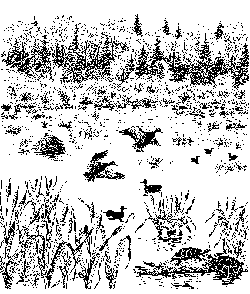 Though wetlands often escape the notice of most people, they command the attention of frogs, salamanders and ducks. Wetlands are transition zones between water and land. Wetlands help keep the environment clean and in balance; they also supply some of nature's most biologically productive habitats. They are home to a high diversity of wildlife, including many species at risk, such as blanding's turtle and thread-leaved sundew.
Though wetlands often escape the notice of most people, they command the attention of frogs, salamanders and ducks. Wetlands are transition zones between water and land. Wetlands help keep the environment clean and in balance; they also supply some of nature's most biologically productive habitats. They are home to a high diversity of wildlife, including many species at risk, such as blanding's turtle and thread-leaved sundew.
Description
An expansive rolling sphagnum bog, a tiny roadside marsh, and a shallow, sheltered, rush-filled lakeshore are all examples of a freshwater wetland. So, what is a wetland? In general, a wetland is any area of land that is regularly covered or soaked with water for part or all of the year. Wetlands are characterised by the presence of wet-adapted species such as waterlilies, painted turtles and dragonflies. Wetlands are neither land, nor water; they are transition zones that combine features of both.
Black spruce
|
Wetland habitat tends to develop in places where water collects and remains at or near the surface. Low lying areas are ideal places for wetlands. Many wetlands exist close to streams, rivers and lakes. Seasonal flooding helps maintain wet conditions throughout much of the year. There are over 35,000 freshwater wetlands in Nova Scotia about fifteen per cent of the province's total land area!
Wetlands come in lots of different shapes and sizes. The major types of freshwater wetland habitat found in Nova Scotia include bogs, fens, floodplains, lakeshores, marshes and swamps.
Bogs are self-contained wetlands that are covered with sphagnum moss and filled with decomposing sphagnum or 'peat'. Often rainfall is a bog's sole source of water. Usually knee-high shrubs cover the surface of a bog and coniferous trees border the edge. The waters of bogs are cold, acidic and distinctively tea-coloured due to staining by peat. Compared to other wetlands, bogs tend to be most lacking in nutrients, providing only marginal habitat for most wildlife. Though diversity of wildlife is low in bogs, many of the species that live in bogs are not found elsewhere. For instance, bog dwelling plants, such as the eastern mountain avens and the insect-eating sundews, are specially adapted to living in nutrient-poor conditions.
Sundew  |
Fens are fairly similar to bogs in their overall appearance. However, unlike bogs, fens receive water from surrounding lands and have defined drainage systems. Because water and nutrients move through fens, conditions are more favourable for growth in fens than in bogs. Consequently, fens support a greater abundance and variety of wildlife than do bogs. Sedge tends to be the predominant plant in fens. The peat formed in fens is composed mostly of decaying sedge, rather than moss as in bogs.
Floodplains develop along large rivers in flat, low lying areas that experience seasonal flooding. Floodplains are characterised by moist soil conditions during the growing season and fine nutrient-rich soil deposited by floodwaters. The combination of high nutrient-levels, high moisture and regular physical disturbance creates unique, productive habitat for wildlife.
Common snipe 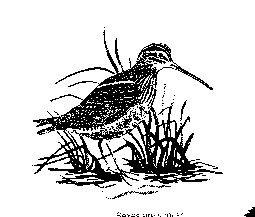 |
Lakeshores provide wetland habitat in shallow protected areas where sunlight can penetrate to the lake bottom. In unprotected areas of lakes, strong wave action prevents plants, and hence wetland habitat, from establishing. Lakeshore wetlands appear mostly as open water with some intermixing of plants. A variety of aquatic plants, including pickerelweed, waterlilies and rushes, flourish in lakeshore habitat. Ring-necked ducks, yellow perch and sandpipers are common visitors to this habitat. Nutrient levels in lakeshore wetlands range from low to moderately high, depending on the features of the surrounding area, such as soil type and human activity.
Yello-spotted salamander  |
Swamps are wetlands dominated by trees and/or shrubs. They receive water from surrounding lands and tend to be soggy places, rather than wet ones. During wetter seasons, swamps may hold standing or gently flowing water. Red maple, black spruce and larch commonly grow in swamps, as do mosses, grasses and ferns. Swamps are nutrient-rich sites that offer superb habitat for wood frog, yellow-spotted salamander, little brown bat and birds, such as tree swallow, broad-winged hawk and common yellowthroat.
Marshes are essentially wetter swamps. Commonly, they occur along lakes and rivers in areas that flood. Unlike swamps, marshes tend to be covered with water year-round. In terms of vegetation, marshes are dominated by non-woody aquatic plants; conditions usually are too wet for trees and shrubs. Cattails, rushes and pondweeds are typical marsh plants. Extremely biologically productive, marshes provide critical habitat for a variety of animals, including black ducks, muskrats, bullheads, predacious diving beetles, pickerel frogs and snails.
Black duck 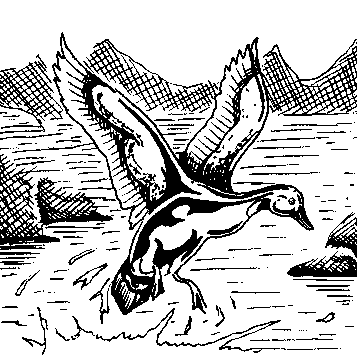 |
Wetlands and wildlife
Clearly, wetlands provide food and protection to many species of wildlife. Wood ducks, beavers, muskrats, american bitterns, painted turtles and water boatmen live in or around water and require wetlands to survive. Similarly, plants such as the pitcher plant, sundew, bulrush and cattail grow exclusively in wetlands. Rare animals, like the four-toed salamander, and plants, such as the coastal plain flora, depend on wetlands for their survival.
Little brown bat 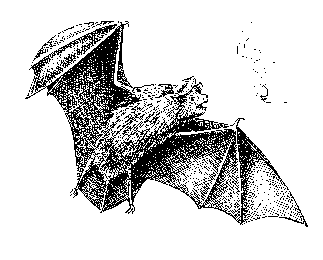 |
Generally, wetlands are areas where animals can find plenty of protective cover and forage. Animals as diverse as green winged teal, moose, deer, little brown bats, sticklebacks and northern ribbon snakes forage in wetlands. Not surprisingly, since there is such a wealth of food and protection in wetlands, these habitats serve as 'nurseries' for the young of many species of fish, birds and amphibians. Many ducks nest and raise their young in wetlands. A common sight in marshes is a brood of ducklings obediently bobbing behind their parents. Wetlands are safe places to start out life.
Ducklings  |
Wetlands and the environment
Wetlands are quietly working to keep the environment clean and in balance. The community of wetland plants effectively absorb and break down contaminants, preventing many toxic chemicals from entering the water supply. Wetlands are nature's water purifiers.
Wetlands help regulate the supply of water in nature. By gathering water during times of flooding and releasing it gradually during periods of drought, wetlands stabilise levels of surface water and reduce soil erosion and its damaging side effects. Wetlands also replenish the water supply stored deep underground. Waters contained by wetlands remain in place long enough to allow some downward seepage into the ground water supply.
Conservation
The biggest single threat facing wetlands is land development. The draining and developing, or so-called 'reclaiming', of wetlands still occurs. As well, poor land use practices in an adjacent area can devastate a wetland. Fortunately, trends are shifting. Increasingly, people are recognising how essential wetlands are to the well-being of wildlife, the environment and society. This world-wide realisation has encouraged global efforts to conserve remaining wetlands.
Northern spring peeper 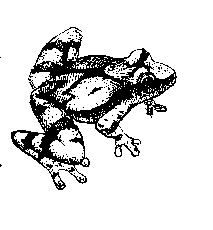 |
More landowner are now practising sustainable land uses on adjoining lands to help conserve wetland habitats. People with wetland habitat on their property, instead of in-filling these areas, are electing to maintain them for the benefit of wildlife. Many community groups are adopting a local wetland or restoring an abused wetland and transforming it into productive, healthy wildlife habitat; some people are even creating new wetland habitat in their neighbourhood. We all benefit.
Attitudes towards wetlands are improving. Efforts in Nova Scotia and around the world are helping to keep wetlands working for the good of nature. Wetlands are now receiving the recognition and care they rightfully deserve.
Respecting Wetlands... |
|
|---|---|
|
|
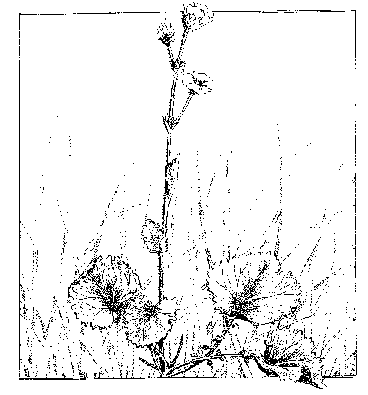
Eastern mountain avens


